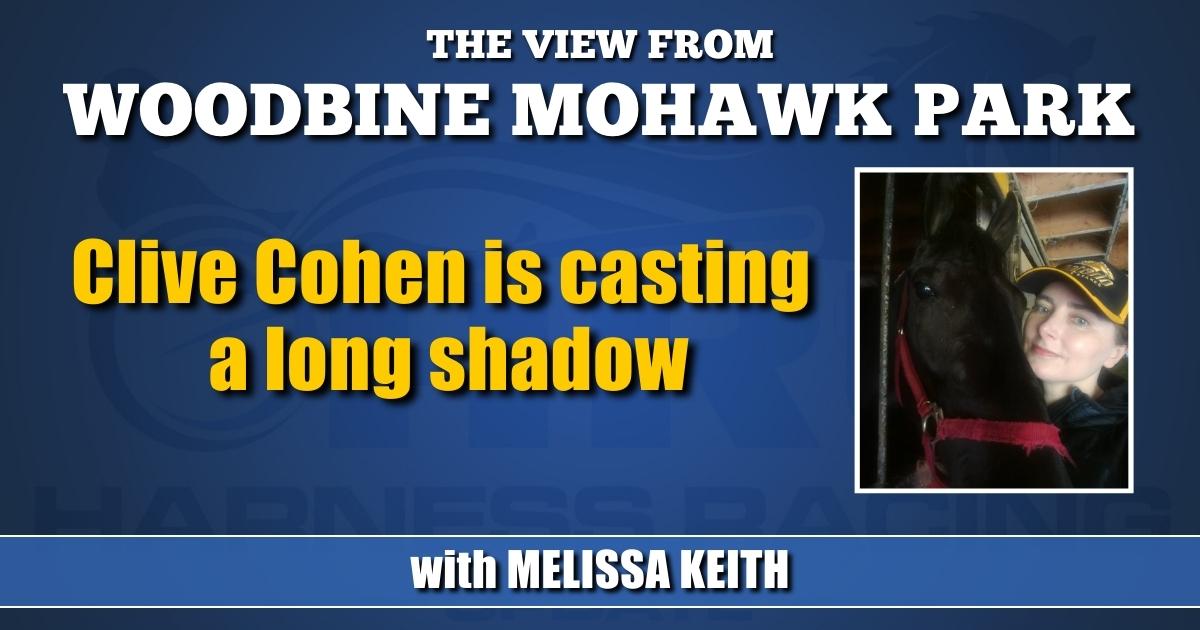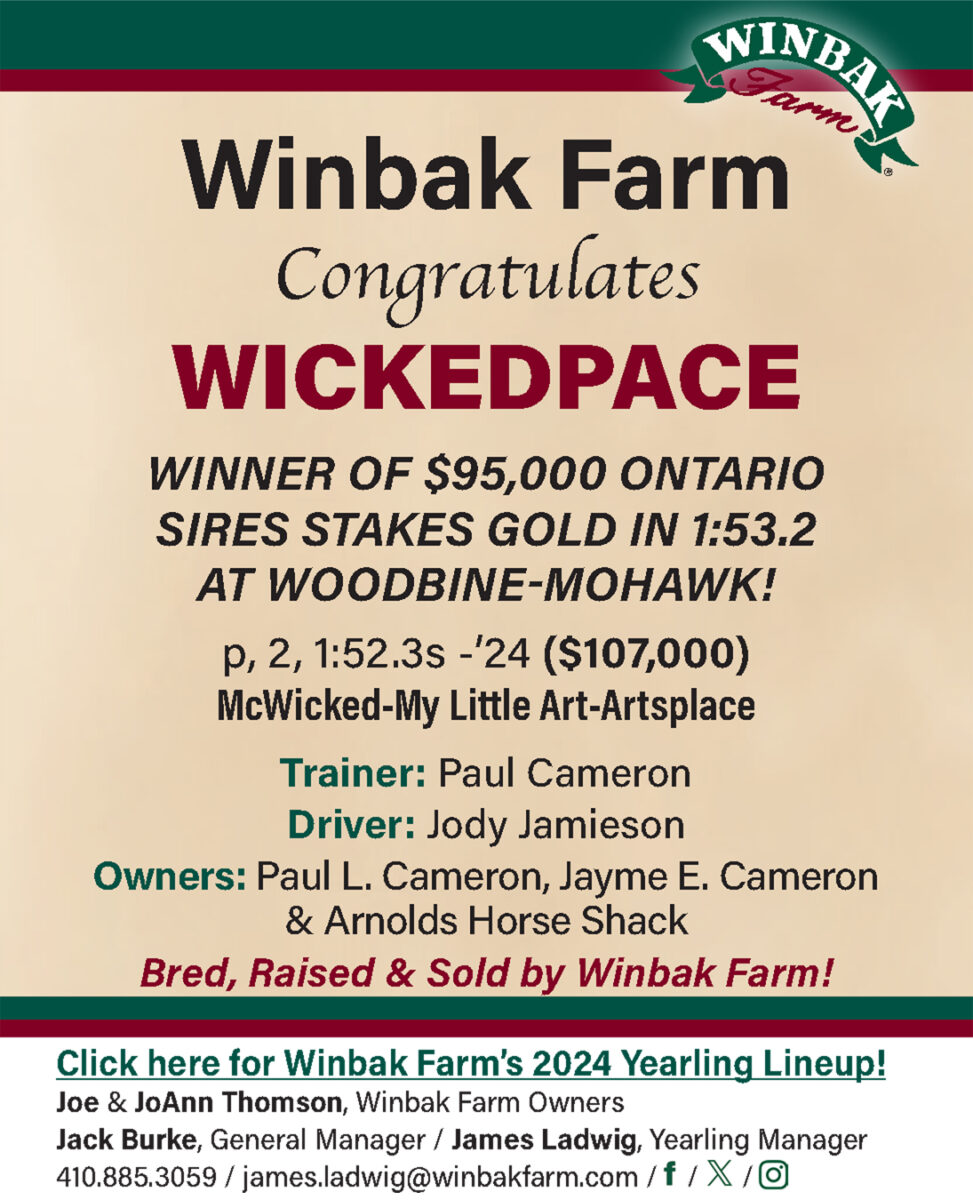

Casting a “long shadow”
Track photographer Clive Cohen on 26 years behind the camera.
by Melissa Keith
Clive Cohen doesn’t miss many Saturday nights at Woodbine Mohawk Park, but Feb. 4 was an exception. The lead photographer for New Image Media was instead taking photos at the O’Brien Awards, celebrating Canada’s best harness racing performers of 2022, and also accepting his seventh Standardbred Canada Media Excellence Award for Outstanding Photography. He had previously won in 2013, 2014, 2016, 2018, 2020, and 2021.
“When I’m not shooting [photos] and my son [2017 George Smallsreed Award winner Jacob Cohen] is also not shooting, then Mario [Glynn] works for me,” Cohen said. “He’s worked for me for probably 15 years at this point. When I was shooting at the [O’Brien] Awards, he was shooting at the track that night.”
March 2023 will mark Clive Cohen’s 26th anniversary as Mohawk’s track photographer. He recalled how he originally started out at the Campbellville, ON track.
“I got into it because the person who was doing Woodbine and Mohawk standardbreds had had enough and he got out of it.” Cohen said. “That was Brian Smiley. He was in it for about the 50 years before me, give or take…He had to run a full darkroom in his basement and it was a whole production at that time.”
Cohen’s connection to harness racing came courtesy of crossing paths with Dave Briggs, early in both of their careers.
“I had been working with, of all people, [HRU editor/journalist] Dave Briggs, at my internship after college [at the London Free Press],” Cohen said. “That’s where Dave was working too; I think it was sports he was doing there, writing. Then Dave moved on to The [Canadian] Sportsman [magazine] right after the Free Press. Then I started shooting freelance with The Sportsman, and when [Brian Smiley] was looking to get out, he saw that I was doing some shooting in that industry, and I think got my name and number through Dave.”
It’s fitting that Cohen’s first experimentation with drones produced his latest award-winning image, “The Long Shadow.” Photographic technology has dramatically changed over the past quarter-century. Consider that when he started as track photographer in March 1997, as Cohen recalled, “there was no digital.”
Demand for winner’s circle pictures and images for publications required finding a reliable place to develop film.
“We contracted someone to do our printing for us,” Cohen said. “I can do color darkroom and black-and-white darkroom, but there’s no way I was going to set it up, at that point, because I found someone who would and he had told me about the nightmare of it. I know how finicky color printing is. So right away, there was a very good printing place, like a Kodak store, near me, and I got them to do all my printing for me from day one.
“I was living in Richmond Hill, and there was a place up there, so every morning I would drop off film to them, and every afternoon they would print it, and I would pick up [prints] on my way back into the track that night.”
Just a few years into his job as track photographer, darkrooms became optional.
“Digital was clearly on the horizon, with no end in sight,” Cohen said. “Color darkroom set-ups are very expensive and very chemical-intensive. It’s way worse than black-and-white in every regard. So, that was ‘97, and by ‘01, we were 100 per cent digital.”
Last year was a special one for Cohen and his 23-year-old son Jacob, who attends Toronto’s York University. They followed Ontario-based Bulldog Hanover beyond his home track, capturing the O’Brien Horse of the Year’s career highlights with their cameras.
“We went to see ‘Bulldog’ race and take photos of him for you guys [HRU] at The Red Mile, and then we also shot him at his final race at The Meadowlands, together,” Cohen said.
The photogenic stallion brought back memories of another star pacer he had followed from Mohawk to the United States.
“[Jacob] was too young at that point, but it reminded me of the last horse I followed around, Somebeachsomewhere,” Cohen said. “That was ‘08. I also followed him to The Red Mile and The Meadowlands. There have been a lot of good stories since then, but nothing has eclipsed ‘Bulldog’ and ‘Beach.’ Those were the two big, big ones who stirred the industry and really garnered a lot of excitement.”
In the years between those two champions, cellphone cameras have improved and become widespread. But, according to Cohen, demand for professional racetrack photography remains unchanged.
“I would say it’s the same,” Cohen said. “You know what the funny part is? Half of the professionals that I was working with and working against and trying to get good photos with back then [2008] are the same people that I’m working with and shooting against nowadays. I’m not that worried and I don’t think most professionals are that worried about people on their cellphones, because it’s a completely different photo that they get, in general.
“They are awesome — I use my iPhone plenty to get tons and tons of photos — but there’s still a very big difference between taking it with the phone and taking it with a real camera.”
His 2022 Media Excellence Award-winning photo, “The Long Shadow,” illustrates the patience, planning and proficiency required to take a perfect aerial shot of an anonymous horse and driver at Woodbine Mohawk Park.
“I tried out a drone for a few weeks, and that’s one of the shots from it,” Cohen said. “Almost everything else would have been from my camera, one way or another. We borrow and use and buy GoPros and drones and different tools to get some different angles.
“That shot [“The Long Shadow”], funny enough, I had thought of doing for years, because in the summer, the shadows of the grandstand and the shadow of the paddock kind of form a border, and there’s a very hard shadow that comes out. But it’s got to be a clear night; there’s got to be horses in the right place; a whole lot of things have to fall into place, and I have been trying to get that for…I can’t tell you how long.
I’ve also tried to get it from a ladder, shooting down in that direction from the top of the stretch. It’s just a shot I’ve been trying to get. It’s been there in my mind for a while, and finally it all came together.”
Organizing images for ready retrieval is another area where Cohen said he’s witnessed innovation during his career.
“I think we’re in the same bind as most companies that produce a lot of images these days,” Cohen said.” Luckily, the computers and the cloud servers are incredible. Every photo is filed by horse’s name and by day of the week, and by month, and by year, and then we have TrackIT to help us look for things if we can’t find them for some reason. Most photos, luckily, with the amazing technology, I can pull up very easily from any computer or my phone. As long as it was taken after ‘01, I have instant access to almost everything.”
It makes his job easier when it comes to printing the ever-popular WMP winners’ circle photos. (Options are displayed at legendsofwoodbine.com).
“Oh yeah, people love their photos, there’s no question,” Cohen said. “We sell photos for most races…We do a lot of mailing out of cardboard-stuffed envelopes to owners all around North America…We send to Australia, New Zealand, Europe. For big races and lifetime marks and special races, we do an amazing amount of enlargements and framed prints also.”
The popularity of certain horses makes for best-selling winner’s circle photos.
“The big ones that stick out in my head are of course ‘Bulldog,’ ‘Beach’ and [2005 O’Brien Horse of the Year] Admirals Express [p, 9, 1:48.2s; $1,766,644],” Cohen said. “People loved getting into those photos too. Most owners are very, very happy to have other people in the winner’s circle with them. So, fans would come in all the time and almost always buy shots of the winner’s circle for that race.”
The three-time George Smallsreed Award winner (2015, 2016, 2021) is in regular contact with the people in the best mood at Woodbine Mohawk Park.
“As people often joke with me, they love seeing me,” Cohen said. “They just won a race. I only see happy people: whoever didn’t win a race doesn’t come to tell me how sad they are, but everyone that wins, I see minutes after the race and it never gets old, as everyone knows. It never gets old winning a race anywhere, let alone one of the greatest tracks in North America, definitely the greatest track in Canada. No matter what class you’re in, no matter what stakes race you’re in, it’s always great to win there.”
As with winning a race, there is always a degree of luck involved in creating an award-worthy image.
“I love my photos, I love taking photos and when something comes out that’s particularly striking, I’m as thrilled today with it as I was when I started doing this years ago,” Cohen said. “Whether you’re writing articles or making movies or photos, you never stop and you never rest on it.”
Cohen admires the work of his American peers Mark Hall (USTA), Michael Lisa (The Meadowlands) and Chris Gooden (The Meadows).
“I see other peoples’ photos and I’m like, ‘I wish I had something like that!’” Cohen said with a laugh. “But there’s always another shot to take and there’s always another scenario that plays out with the horses or the lighting or the clouds or the rain…Who knows what?”
Working at Mohawk gives Cohen a unique vantage point on each season’s emerging talent.
ry lucky in that I get to see the 2-year-olds hit the track for the first time,” Cohen said. “I get to see the happy owners and trainers come into my office when their 2-year-old wins for the first time. Anything is possible at that point, in the late summer or early, whenever they’re finally hitting the track, and the world is theirs at that moment. They could have the greatest horse on earth or never win again, but there’s so much possibility.
“A lot of the owners I know are also breeders and [when] the homebreds come out, it’s very exciting to watch them go through the OSS [Ontario Sires Stakes] ranks or make it to the stakes and compete in the big stakes races. While I certainly don’t have a stake in any of those, I feel I’m a part of the story.”

















